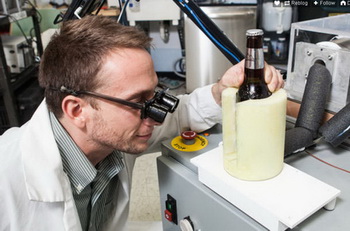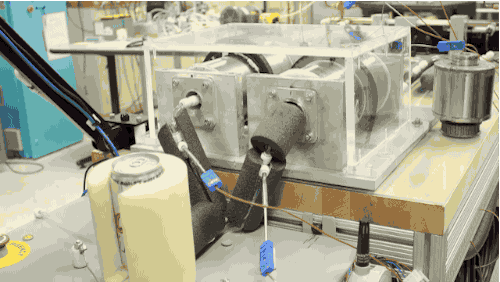OOPS! You forgot to upload swfobject.js ! You must upload this file for your form to work.
General Electric talk about progress in the development of magnetic refrigerators
![]()
|
xtreview is your : Video card - cpu - memory - Hard drive - power supply unit source |
|
|||
|
|
||||
 Recommended : Free unlimited image hosting with image editor
Recommended : Free unlimited image hosting with image editor
|
POSTER: computer news || GENERAL ELECTRIC TALK ABOUT PROGRESS IN THE DEVELOPMENT OF MAGNETIC REFRIGERATORS |
DATE:2014-02-11 |
|
|
One hundred and twenty-three years ago - in 1881 - German scientist Emil Warburg (Emil Warburg) was opened so-called magnetocaloric effect (magnetocaloric effect). Its essence is that the magnetic materials can dissipate heat during magnetization and demagnetization at accumulating it. Based on FEM effect was proposed magnetic refrigerator, the first experiments which were conducted in 1933. But then failed to prove the effectiveness of such systems to create industrial installations. Operating temperature range was too small. Towards the creation of magnetic refrigerators back about ten years ago.  General Electric Company is working on a new generation of magnetic refrigerators along with other developers. If anyone is an expert in refrigeration systems, so it is GE, .Moreover, according to the researchers from GE, the company has come close to creating an efficient design of the refrigeration system of the new century. In other words, magnetic refrigerators can become a daily reality in 10 years. Pilot plant collected developer GE - Venkartom Venkatakrishnanom (Venkat Venkatakrishnan) - reduces the temperature of the coolant at 80 degrees Celsius. While the coolant is based on plain water, which promises to cause less harm to nature. However, to make the magnetic properties of the water in it will make paramagnetic metal alloys, so that from the point of view of compliance with environmental certain precautions still have to abide by.  In the pilot plant are based permanent magnet blocks, which for the creation of an alternating magnetic field is given a reciprocating motion. This saves energy spent on cooling. Estimated developers such magnetic refrigerators will be 20-30% more efficient compressor. Related Products : | ||
|
|
||
|
xtreview is your : Video card - cpu - memory - Hard drive - power supply unit source |
|
|
|
|
||
|
Xtreview Support  N-Post:xxxx Xtreview Support        |
GENERAL ELECTRIC TALK ABOUT PROGRESS IN THE DEVELOPMENT OF MAGNETIC REFRIGERATORS |
| Please Feel Free to write any Comment; Thanks  |
Russian scientists presented ferroelectric MELRAM (2017-08-27)
Tesla trunking tractor will not exceed 480 km on electric traction without recharging (2017-08-25)
Hyundai promises to produce an electric car with a power reserve of 500 km (2017-08-17)
Tesla prepares to begin testing electric trucks with autopilot (2017-08-10)
The cover of Tesla Model 3 charging port is equipped with an electric drive (2017-08-07)
Toyota and Mazda have formed an alliance that will help jointly develop electric vehicles (2017-08-05)
Toyota promises to develop an electric car, charged in a few minutes (2017-07-25)
Some electric vehicles Tesla Model S are equipped with more capacious batteries (2017-07-25)
The developer of the fastest electric vehicles in the world is ready to surrender to Ford (2017-07-18)
Tesla invites the first recipients of electric vehicles Model 3 to the presentation (2017-07-18)
Ilon Mask is skeptical about the location of solar cells on the roof of an electric vehicle (2017-07-17)
Tesla electric vehicles have already driven 8 billion kilometers (2017-07-15)
Lucid Motors managed to overclock the electric car to 378 km-h (2017-07-11)
Tesla will receive a more pristine electric motor (2017-07-05)
Tesla showed a partial sketch of the electric-crossover Model Y (2017-06-09)
Toyota will help create a sample of the electric plane by the end of 2018 (2017-06-05)
Tesla will abolish versions of electric vehicles with a battery capacity of 90 kWh (2017-06-05)
GP106 GPU In the on-board supercomputer of Tesla electric vehicle (2017-05-24)
Head of Toyota compared electric vehicles Tesla with iPhone (2017-05-22)
Electric crossover Ford will be able to travel about 500 km without recharging (2017-05-22)
![]()
To figure out your best laptops .Welcome to XTreview.com. Here u can find a complete computer hardware guide and laptop rating .More than 500 reviews of modern PC to understand the basic architecture


7600gt review
7600gt is the middle card range.
We already benchmarked this video card and found that ...

 geforce 8800gtx and 8800gts
geforce 8800gtx and 8800gts  Xtreview software download Section
Xtreview software download Section  AMD TURION 64 X2 REVIEW
AMD TURION 64 X2 REVIEW  INTEL PENTIUM D 920 , INTEL PENTIUM D 930
INTEL PENTIUM D 920 , INTEL PENTIUM D 930  6800XT REVIEW
6800XT REVIEW  computer hardware REVIEW
computer hardware REVIEW  INTEL CONROE CORE DUO 2 REVIEW VS AMD AM2
INTEL CONROE CORE DUO 2 REVIEW VS AMD AM2  INTEL PENTIUM D 805 INTEL D805
INTEL PENTIUM D 805 INTEL D805  Free desktop wallpaper
Free desktop wallpaper  online fighting game
online fighting game  Xtreview price comparison center
Xtreview price comparison center Lastest 15 Reviews


Rss Feeds
Last News
- The new version of GPU-Z finally kills the belief in the miracle of Vega transformation
- The motherboard manufacturer confirms the characteristics of the processors Coffee Lake
- We are looking for copper coolers on NVIDIA Volta computing accelerators
- Unofficially about Intels plans to release 300-series chipset
- The Japanese representation of AMD offered monetary compensation to the first buyers of Ryzen Threadripper
- This year will not be released more than 45 million motherboards
- TSMC denies the presentation of charges from the antimonopoly authorities
- Radeon RX Vega 64 at frequencies 1802-1000 MHz updated the record GPUPI 1B
- AMD itself would like to believe that mobile processors Ryzen have already been released
- AMD Vega 20 will find application in accelerating computations
- Pre-orders for new iPhone start next week
- Radeon RX Vega 57, 58 and 59: the wonders of transformation
- ASML starts commercial delivery of EUV-scanners
- The older Skylake processors with a free multiplier are removed from production
- Meizu will release Android-smartphone based on Helio P40
- AMD Bristol Ridge processors are also available in American retail
- The fate of Toshiba Memory can be solved to the next environment
- duo GeForce GTX 1080 Ti in GPUPI 1B at frequencies of 2480-10320 MHz
- New Kentsfield overclocking record up to 5204 MHz
- Lenovo released Android-smartphone K8

HALO 3 HALO 3 - Final Fight!

PREY Prey is something you don t often see anymore: a totally unigue shooter experience.

computer news computer parts review Old Forum Downloads New Forum Login Join Articles terms Hardware blog Sitemap Get Freebies


